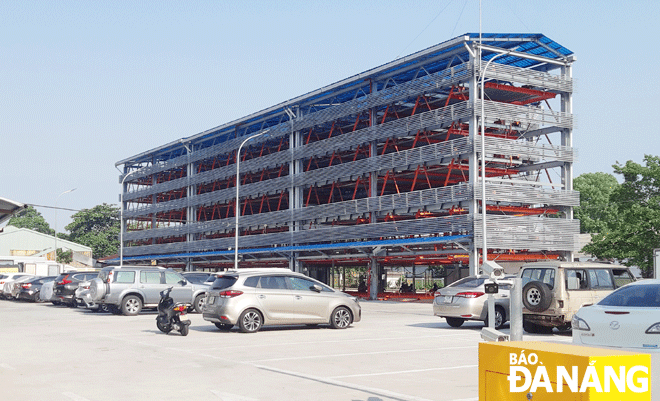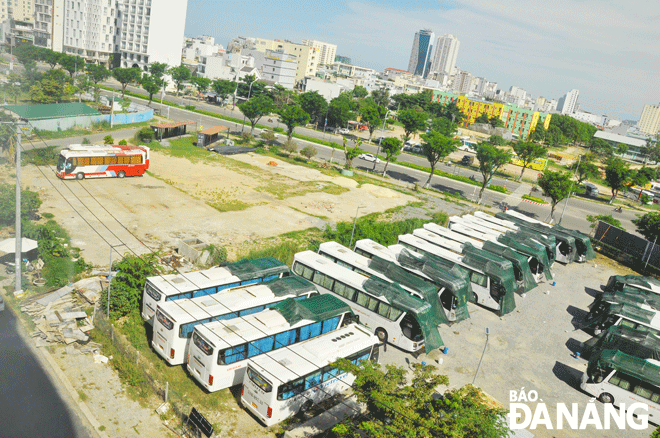Da Nang mulls over using vacant lots for parking lots
By the end of June 2023, Da Nang had more than 107,400 cars, an increase of more than 5,200 vehicles from the beginning of 2023, and nearly 1 million motorbikes, the Da Nang Department of Transport just reported. In the face of a sharp hike in the volume of personal cars, it is high time for the city to quickly accelerate possible solutions.
 |
| Smart parking lot at 166 Hai Phong, Da Nang has just been built. It is one of the city’s projects in the plan of digital transformation in the transportation sector. Photo: THANH LAN |
According to architect Vu Quang Hung, the Head of the Authority of Da Nang Hi-tech Park and Industrial Zones, given the above-mentioned number of vehicles, the city needs 230 ha of static traffic area to meet a growing demand for parking lots, not to mention those for vehicles from other parts of the country flocking to Da Nang.
However, Da Nang currently has only about 24.8ha of parking area, only for a total of more than 11,000 parking positions, reaching about 33% of the demand as compared to the plan by 2025. Recently, the building of 2 smart parking facilities using state-funded capital has completed respectively at 166 Hai Phong with 173 parking slots and at 255 Phan Chau Trinh with a scale of 50 parking positions.
In addition, the municipal administration has assigned relevant agencies to invest in multi-storey smart parking lots to the south of Ngu Hanh Son District-based Muong Thanh Hotel and at 8 Phan Boi Chau, a smart parking at the Da Nang Administration Centre and an underground park lot to the south of this building.
Alongside the use of public investment, the Da Nang government has called on businesses to invest in smart parking lots in the form of public-private partnerships such as parking lots at 51A Ly Tu Trong, 172 Nguyen Chi Thanh, 9 Le Hong Phong, 10 Ly Thuong Kiet, A1.1 to southeast of the Pham Van Dong - Ngo Quyen intersection, A1.2 northeast of the Duong Dinh Nghe - Ngo Quyen intersection, southwest of the Phan Tu - Vo Nguyen Giap intersection.
Also, smart parking lots are expected to take the shape soon at 24 commercial and service buildings or apartments across the city so as to increase land use efficiency. However, the implementation still faces many difficulties, causing frequent parking shortages.
A a recent meeting, architect Vu Quang Hung not only raised a deep concern over a shortage of parking spaces, the risk of traffic jams, but also proposed a series of possible and specific solutions to solve the problem.
Specifically, there is a fact that the parking area is too low, causing traffic jams, obstructing vehicle circulation, inevitably affecting people's travel and trade, and that the situation is forecasted to get worse.
Currently, in the city, there are still many vacant land plots earmarked for production, business, commercial and service activities, along with urban residential land combined with trade and services which have been assigned to individuals, households and organisations but have been left vacant or unused for many years. This, in fact, causes a waste of land resources. Therefore, in the short term, it is highly recommended that Da Nang should use vacant land for temporary parking.
 |
| Here is a temporary parking lot on Vo Van Kiet Street, Son Tra District, Da Nang. Photo: THANH LAN |
Alongside the above-mention recommendations, it is also a must-do to re-arrange ‘no parking’ signs along local streets, especially busy downtown ones. With regard to the long-term solution, according to architect Vu Quang Hung, Da Nang needs to increase the area and number of parking lots in the current subdivision planning process.
Having many parking lots will be convenient for people's activities as well as stimulating tourism and shopping, and at the same time, the city needs to develop parking lots in combination with parks and flower gardens to increase parking capacity in the urban centre.
Also, the municipal administration should promulgate mechanisms and policies to encourage the private sector to invest in the construction of parking lots. Making use of yards of offices and schools for temporary parking should be taken into account.
In particular, other measures include the upgrade of the parking information system, specifically providing information about the number of available parking spaces and the location through signage or mobile phone apps to help users search for parking spaces in more convenient manner, enhancing the use of public transport; forming green - shady streets where people can walk along their sidewalks, arranging more public bike stations near bus routes to facilitate transit, planning lanes exclusively for bikes, diversifying types of from popular to high-end busses to serve many passengers of different choices.
Last, but not least, it is not necessary to build large-scale parking lots, mainly for overnight parking or only located within a 500m walking distance of the parking site in order to stimulate tourism, shopping and product commercialisation, in this difficult economic time
Reporting by THANH LAN - Translating by A. THU